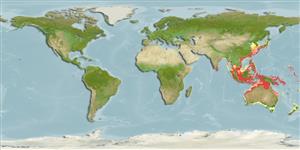Teleostei (teleosts) >
Anguilliformes (Eels and morays) >
Ophichthidae (Snake eels) > Ophichthinae
Etymology: Ophichthus: Greek, ophis = serpent + Greek, ichthys = fish (Ref. 45335).
More on authors: Jordan & Richardson.
Environment: milieu / climate zone / depth range / distribution range
Ecology
Marine; benthopelagic. Tropical
Indo-West Pacific: Taiwan, the Philippines, northern Australia, India, and Myanmar.
Size / Weight / Age
Maturity: Lm ? range ? - ? cm
Max length : 148 cm TL male/unsexed; (Ref. 123091)
Found on soft bottom, inshore (Ref. 75154); in shallow sand and mud bottom (Ref. 123091).
Life cycle and mating behavior
Maturity | Reproduction | Spawning | Eggs | Fecundity | Larvae
Hoese, D.F., D.J. Bray, J.R. Paxton and G.R. Allen, 2006. Fishes. In Beasley, O.L. and A. Wells (eds.) Zoological Catalogue of Australia. Volume 35 Australia: ABRS & CSIRO Publishing, 2178 p. (Ref. 75154)
IUCN Red List Status (Ref. 130435: Version 2024-2)
Threat to humans
Harmless
Human uses
Fisheries: of no interest
Tools
Special reports
Download XML
Internet sources
Estimates based on models
Preferred temperature (Ref.
123201): 22.6 - 29, mean 28 °C (based on 1228 cells).
Phylogenetic diversity index (Ref.
82804): PD
50 = 0.5000 [Uniqueness, from 0.5 = low to 2.0 = high].
Bayesian length-weight: a=0.00091 (0.00039 - 0.00215), b=2.99 (2.79 - 3.19), in cm total length, based on LWR estimates for this (Sub)family-body shape (Ref.
93245).
Trophic level (Ref.
69278): 4.2 ±0.7 se; based on size and trophs of closest relatives
Resilience (Ref.
120179): Low, minimum population doubling time 4.5 - 14 years (Preliminary K or Fecundity.).
Fishing Vulnerability (Ref.
59153): Very high vulnerability (89 of 100).
